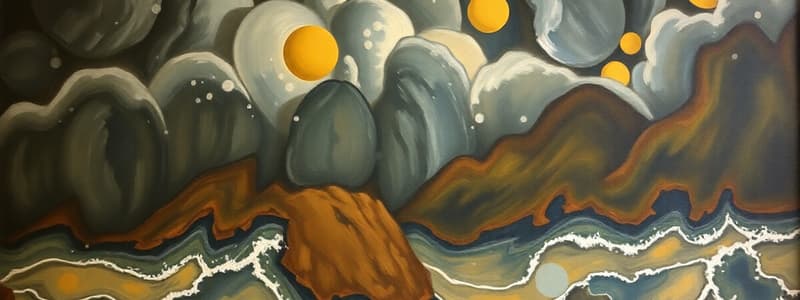Podcast
Questions and Answers
What happens to the age of oceanic rocks as one moves away from an ocean ridge?
What happens to the age of oceanic rocks as one moves away from an ocean ridge?
- The age varies randomly
- The age increases (correct)
- The age decreases
- The age remains constant
Which statement best describes the sea-floor spreading process?
Which statement best describes the sea-floor spreading process?
- New oceanic crust is formed at deep-sea trenches.
- Magma moves towards the surface of the crust along ocean ridges. (correct)
- Magma is pushed downward into the mantle along ocean ridges.
- Continental landmasses push through oceanic crust.
How does the thickness of ocean-floor sediments change in relation to distance from an ocean ridge?
How does the thickness of ocean-floor sediments change in relation to distance from an ocean ridge?
- Thickness decreases with distance
- Thickness varies but does not follow a pattern
- Thickness remains the same regardless of distance
- Thickness increases with distance (correct)
What distinguishes oceanic crust from continental crust?
What distinguishes oceanic crust from continental crust?
What misconception did Wegener hold about continental movement?
What misconception did Wegener hold about continental movement?
What was the name of the single landmass proposed by Alfred Wegener that broke apart approximately 200 million years ago?
What was the name of the single landmass proposed by Alfred Wegener that broke apart approximately 200 million years ago?
Which evidence did Wegener use to support his hypothesis of continental drift regarding fossil distribution?
Which evidence did Wegener use to support his hypothesis of continental drift regarding fossil distribution?
What role do magnetometers play in the study of ocean floor geology?
What role do magnetometers play in the study of ocean floor geology?
How did Wegener conclude that Antarctica must have been closer to the equator in the past?
How did Wegener conclude that Antarctica must have been closer to the equator in the past?
What geographical features are formed at the boundaries where one tectonic plate goes under another?
What geographical features are formed at the boundaries where one tectonic plate goes under another?
What technological advancement allowed scientists to map the ocean floor and measure water depth?
What technological advancement allowed scientists to map the ocean floor and measure water depth?
What significant glacial evidence did Wegener refer to in support of his theory of continental drift?
What significant glacial evidence did Wegener refer to in support of his theory of continental drift?
Which of the following statements was NOT part of Wegener’s hypothesis for continental drift?
Which of the following statements was NOT part of Wegener’s hypothesis for continental drift?
Flashcards
Continental Drift
Continental Drift
Alfred Wegener's hypothesis that Earth's continents were once joined in a single landmass called Pangea, which broke apart around 200 million years ago, sending the continents adrift.
Fossil Evidence for Continental Drift
Fossil Evidence for Continental Drift
Similar fossils of animals and plants found on widely separated continents, suggesting they once lived in a connected landmass.
Rock Formations and Continental Drift
Rock Formations and Continental Drift
Matching rock formations, like those found in the Appalachian Mountains of North America and similar mountains in Greenland and Europe, support the idea of once joined landmasses.
Glacial Evidence for Continental Drift
Glacial Evidence for Continental Drift
Signup and view all the flashcards
Magnetometer
Magnetometer
Signup and view all the flashcards
Ocean Ridges
Ocean Ridges
Signup and view all the flashcards
Deep-Sea Trenches
Deep-Sea Trenches
Signup and view all the flashcards
Ocean Rocks and Sediments
Ocean Rocks and Sediments
Signup and view all the flashcards
Seafloor spreading
Seafloor spreading
Signup and view all the flashcards
How the age of ocean floor relates to distance from a ridge
How the age of ocean floor relates to distance from a ridge
Signup and view all the flashcards
Ocean floor sediment thickness
Ocean floor sediment thickness
Signup and view all the flashcards
Seafloor spreading and continental movement
Seafloor spreading and continental movement
Signup and view all the flashcards
Oceanic crust vs. continental crust
Oceanic crust vs. continental crust
Signup and view all the flashcards
Study Notes
Continental Drift
- In 1912, Alfred Wegener, a German meteorologist, presented his hypothesis of continental drift to the scientific community
- Wegener's hypothesis stated that Earth's continents were once joined in a single landmass, called Pangea
- Pangea broke apart approximately 200 million years ago (mya), causing the continents to drift apart
Evidence of Continental Drift
- Rock formations: Similar rock layers in the Appalachian Mountains (US), Greenland, and Europe suggest the continents were once connected
- Fossils: Similar fossils of animals and plants have been found on continents that are now separated, indicating a shared past
- Climate: Coal deposits found in Antarctica suggest it was once closer to the equator
- Glaciers: Glacial deposits found on multiple continents indicate they were once joined and covered in ice
Mapping the Ocean Floor
- Magnetometers, detecting magnetic fields, helped study ocean floors
- Sonar technology enabled measuring ocean depths and mapping ocean floor topography
- These methods revealed underwater mountain chains called ocean ridges
- Ocean ridges form where magma rises, creating new rock, pushing older rock away from the ridge
- Opposite sides of the ocean ridges show the same magnetic stripes, confirming spreading
Ocean Rocks and Sediments
- Ocean rock and sediment ages increase with distance from ocean ridges, confirming seafloor spreading
- The oldest parts of the seafloor are relatively young in a geological sense
- The oceanic crust is thinner than continental crust
Studying That Suits You
Use AI to generate personalized quizzes and flashcards to suit your learning preferences.




